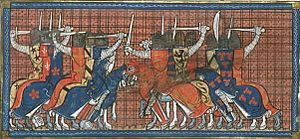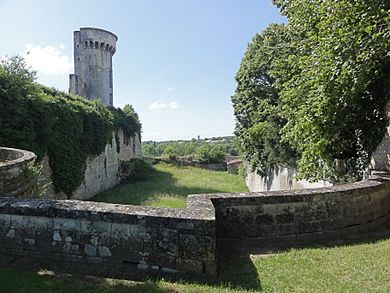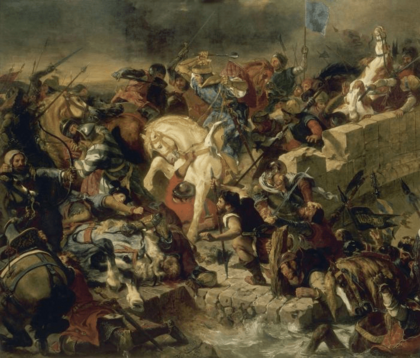Battle of Taillebourg facts for kids
Quick facts for kids Battle of Taillebourg |
|||||||
|---|---|---|---|---|---|---|---|
| Part of the Saintonge War | |||||||
 Battle between the French (Louis IX) and the English (Henry III). (British Library, Royal 16 G VI f. 399) |
|||||||
|
|||||||
| Belligerents | |||||||
| Kingdom of France | Kingdom of England and French allies | ||||||
| Commanders and leaders | |||||||
| Louis IX of France Alphonse of Poitiers |
Henry III of England Richard of Cornwall Hugh X of Lusignan |
||||||
| Strength | |||||||
| 4,000 knights 20,000 infantry |
1,600 knights 700 crossbowmen 20,000 infantry |
||||||
| Casualties and losses | |||||||
| Light | Heavy | ||||||
The Battle of Taillebourg was a very important battle fought in July 1242. It was the main fight of the Saintonge War. This war was between the Kingdom of France and the Kingdom of England.
The French army was led by King Louis IX, also known as Saint Louis. His younger brother, Alphonse of Poitiers, also helped lead. On the other side, the English forces were led by King Henry III of England. He was joined by his brother Richard of Cornwall and his stepfather Hugh X of Lusignan.
The battle first happened at a key bridge over the Charente River. This bridge was important for travel between northern and southern France. Later, fighting moved near the city of Saintes. The English and their allies lost badly. They were forced to make peace.
This battle stopped a rebellion in a region called Poitou. It also ended King Henry III's hopes of getting back lands that his father had lost in France.
Contents
Why the Battle Happened
In 1241, the French King Louis VIII had given the title of Count of Poitou to his younger son, Alphonse. When Alphonse grew up, King Louis IX (Louis VIII's son) held a big meeting. He announced that Alphonse would now officially take over Poitou.
Many important nobles from the Aquitaine region came to this meeting. Among them were Isabella of Angoulême and her husband, Hugh X of Lusignan, the Count of La Marche.
The Lusignan Family's Disagreement
After the meeting, King Louis IX went to Poitiers. He wanted to officially make his brother Alphonse the Count of Poitiers. However, the Lusignan family did not want the French king to have power there. Isabella was especially upset. She felt her son, who was King Henry III of England's brother, should have received the title.
Soon after Louis arrived in Poitiers, he learned that Hugh, the Count of La Marche, had gathered an army. Talks between Louis and Alphonse, and Hugh and Isabella, did not solve the problem.
Armies Gather for War
In April 1242, King Louis IX gathered his army at Chinon. Some people at the time thought it was 50,000 men. Today, historians believe it was closer to 25,000 soldiers. This army included knights, men-at-arms, and foot soldiers. They quickly captured many rebel castles.
On May 20, King Henry III of England arrived. He joined the French nobles who were rebelling. His army was estimated to be around 30,000 men. The two kings sent letters to each other, but they couldn't agree. The main battle would happen at Taillebourg. This was a very important spot near a bridge over the Charente River. This bridge was the border of the lands they were fighting over.
The First Day of Battle

On July 21, the two armies stood on opposite sides of the bridge. The French King Louis IX and Count Alphonse were inside the Château de Taillebourg. This castle looked over the bridge. The bridge was a key path between different regions of France.
King Henry of England and the Count of La Marche set up their army on the other side of the river.
Fighting for the Bridge
The English and the rebels wanted to take the bridge. They attacked the French positions first. The battle ended with a huge charge by French knights. They rushed out from the castle and pushed back their enemies. The English and their allies had to run away towards Saintes.
The Second Day of Battle
After losing the first fight, which gave the French control of the bridge, Henry and Hugh both ran away. They went to Saintes, and then to a region called Gascony. This left their army without leaders.
On July 22, another battle took place north of Saintes. There was a long, messy fight. The English were beaten badly again. These two fights together are known as the Battle of Taillebourg.
What Happened After the Battle
King Louis IX kept chasing the English troops. He captured many prisoners until he reached the city of Saintes. After a short siege, the people of Saintes gave the city's keys to Louis.
King Henry tried one last time to stop France from taking over his lands. He tried to block the port of La Rochelle by sea. But this plan failed. He also tried to build a new army and make alliances with other kings in Europe, but that didn't work either.
In January 1243, Henry sent a letter to Frederick II, the Holy Roman Emperor. He told him that his hopes of getting his lands back in France were over. On March 12, Henry had to ask Louis for a five-year truce, which is a temporary stop to fighting.
Peace Treaties and Outcomes
The truce was signed at Pons on August 1. A more lasting peace agreement was made in Paris on December 4, 1259. This happened because there was a threat of another war in England.
King Louis IX gave back the region of Guyenne to Henry. This was a kind gesture to help keep the peace. Louis wanted peace so he could go on a crusade. He could have forced Henry to give up Bordeaux and Guyenne, which were England's last lands across the sea. But he chose not to.
The end of the rebellion was not good for Hugh of Lusignan. His castles in Poitou were taken, rearmed, and sold by Alphonse of Poitiers. His daughter, Isabel of Lusignan, was even married to his enemy, Geoffrey of Rancon, in 1250. Geoffrey used her dowry to rebuild his castle.
Art Inspired by the Battle

The Battle of Taillebourg is mentioned in an old French song called Molt lieement dirai mon serventois. This song supported King Louis and his allies. It even names some of the historical figures involved.
The famous artist Eugène Delacroix painted the battle. His painting, called The Battle of Taillebourg won by Saint Louis, was shown in 1837. It shows the energy and passion of the French knights' charge.
See also


